Important viral Diseases of Broilers & their Management

Dr. N.K. Mahajan
Prof. & Head (Retd), Department of Veterinary Public Health & Epidemiology,
Lala Lajpat Rai University of Veterinary & Animal Sciences, Hisar-125004 (Haryana, India)
First Choice Veterinary Diagnostic Lab, Safidon Road, JIND (Haryana)
Various infectious diseases affect broilers at different ages and cause economic losses due to heavy mortality, poor FCR and weight loss. Some of the important viral diseases are discussed here:
1. New Castle Disease
It is one of the most dreaded diseases of poultry as it can cause very heavy mortality at a very high speed. The disease is caused by a virus of paramyxovirus group and classified into many serotypes based on the virulence. Chicken is the natural host, but vast majority of birds are susceptible to infection including ducks and turkey.
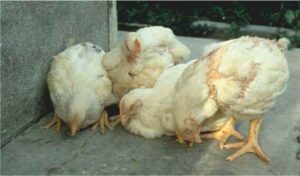
Source:https://www.poultryhub.org/
Signs
Depression, prostration, loss of appetite, greenish/yellowish diarrhea, nervous signs like in- coordination, twitching of neck, heavy mortality in acute outbreaks.
Postmortem Lesions
Pin pointed hemorrhages at the tip of proventricular glands, hemorrhagic/ diphtheritic ulcers in the intestine and caecal tonsils.
Diagnosis
Typical postmortem lesions mentioned above are diagnostic.
Laboratory diagnosis:
hemagglutination (HA), hemagglutination Inhibition (HI) and ELISA tests can be employed for confirmation of antibody titers. Polymerase Chain Reaction (PCR) is done for confirmation of the virus.
Treatment and Prevention
Effective vaccines are available for prevention. F/ B1 / clone vaccine is given at the age of 4-5 days followed by LaSota vaccine at 21 days can protect the bird.
If challenge in the area is high, can also inject ND Killed vaccine along with first vaccine at 4/5-day Vaccination can be done if not done earlier at the time of outbreak also. Provide supportive therapy in the form of Cough syrup (@ 10 ml / 100 birds in drinking water – twice a day), Immunomodulators like Vit. E (@ 5 ml/ 100 birds) once a day for 3-4 days.
2. Infectious Bursal Disease
(Gumboro Disease)
Infectious Bursal Disease (IBD) is a highly contagious viral disease of young chicken causing serious economic losses, occurs mainly between 3-5 weeks of age in broilers. The virus targets the Bursa of Fabricius, an important part of immune system making the bird susceptible to other infections. Vaccination failures may happen due to the associated immuno-suppression.
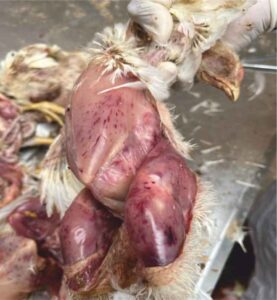
Signs: Dullness, depression, stretch legs backwards, whitish diarrhea and death.
Mortem Lesions: Hemorrhages in the thigh and pectoral muscles, bursa enlarged, edematous and hyperemic with bloody or mucoid contents inside, bursa firm and atrophic in chronic form, kidney may show nephrosis and mottling.
Diagnosis: Bursal lesions are characteristic. Age of the birds affected and hemorrhages on muscles help in diagnosis. Confirmation can be done by PCR.
Prevention
Vaccines are available for prevention which can be done between 11-13 days of age or now such vaccines are available which can be given / injected even on first day at hatchery.
Treatment
Segregate the affected birds, provide electrolytes (@ 1g/ lt of water) and paracetamol. Use Disinfectants like Virkon-S for spray (@4g/ lt of water) and in drinking water (@ 1g / 4lt ),also provide Liver tonic and Immuno-modulators.
3. Avian Influenza
Highly Pathogenic Avian Influenza (HPAI) is a highly lethal systemic disease affecting vast majority of birds caused by the Influenza Type A virus. Because of the zoonotic as well as pandemic potential, the disease gained much public health importance. Water birds and migratory birds act as carriers and spread the infection.
Signs: Sudden, heavy and unusual mortality reaching almost 100% without any clinical signs, edema of face, cyanosis of comb and wattles in less fulminating cases, nervous disorders like tremors, torticollis and opisthotonos.
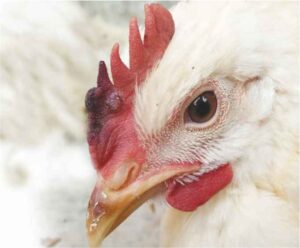
Post mortem lesions
Extremely variable depending on the severity. Hemorrhagic lesions (petechial to ecchymotic) on all the visceral organs, serous membranes, skin and muscles in acute cases.
Lungs pneumonic, enteritis, air sacculitis, splenomegaly.
Diagnosis
Sudden, heavy, unusual mortality (80-90%) create the suspicion. The disease is to be differentiated from the other fulminating diseases of chicken like Newcastle Disease, IB etc., disease can be confirmed from High Security Animal Disease Laboratory, Bhopal.
Treatment
There is no treatment and birds are to be destroyed and buried as per OIE norms.
4. Infectious Bronchitis
Infectious bronchitis is a disease of chickens only.
Clinical signs: The severity of IB infection is influenced by the age and immune status of the flock, by environmental conditions, and by the presence of other diseases. Labored breathing with some gasping in young chickens. Breathing noises are more noticeable at night.
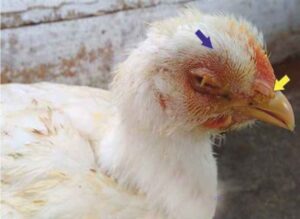
(Source:https://bitchinchickens.com/)
Diagnosis
Post mortem lesions: Characteristic post mortem lesion is presence of bronchial plug on the bifurcation of bronchioles, heamorrhagic tracheitis and CRD due to complication with Mycoplasma.
Control & Prevention:
There is no specific treatment for infectious bronchitis. Antibiotics for 3-5 days may aid in combating secondary bacterial infections. Raise the room temperature by 5°F for brooding-age chickens until symptoms subside. For Prevention: Establish and enforce a biosecurity program. Vaccines are available which can be carried out in endemic farms on 4-5th day of age by Intra-nasal / Oral route.
5. Avian encephalomyelitis (AE)
It is an infectious viral disease affecting young chickens, quail and turkeys characterized by ataxia and tremors of head and neck.Baby chicks of 1 to 2 weeks age are most severely affected. AE is an egg-borne infection. Adult hens get symptomless infection.
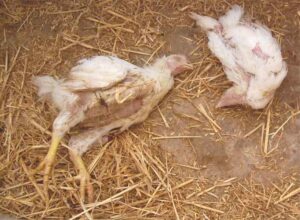
(Source:https://poultrydvm.com/)
Signs: New born chicks show paralysis in the first week after hatching. Progressive ataxia and incoordination, tremors of the head and neck become evident especially after exciting the chicks, mortality rate vary from outbreak to outbreak
Post mortem lesions: No gross lesions are observed. Minute whitish/grayish spots in the muscles of gizzard in a few cases.
Diagnosis/ Prevention
Age of the birds and symptoms are helpful in establishing tentative diagnosis. Screening of breeding stock for infection by carrying out ELISA test for antibody titers and immunization of breeding stock prevent the transmission of virus through eggs.
6. Hydropericardium syndrome (HPS) and Inclusion body hepatitis (IBH):
These two conditions are caused by avian adeno group-1 viruses while fowl adenovirus group-1 serotype 4 is predominantly associated with HPS, most other serotypes cause IBH.
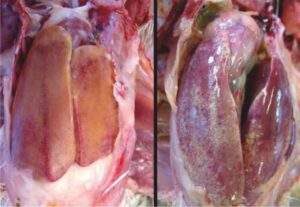
Source: https://www.msdvetmanual.com/
Hydropericardium syndrome is mainly seen in 3-8 week-old broiler chickens and is characterized by sudden death. The most characteristic lesion is hydropericardium. The pericardial sac is filled with a clear or straw coloured fluid. Because of the size of the heart and accumulation of fluid around and the texture, the heart of affected bird appears like litchi fruit and the condition is also referred to as litchi disease which is in fact, a misnomer. The liver may be enlarged and fatty with some hemorrhages. Mortality to the tune of 80% has been recorded.
The liver lesions are prominent in IBH: liver is enlarged and mottled in appearance with necrotic foci. Fatty changes may be seen in liver. Kidneys may be enlarged and filled with urates.
Diagnosis:
The disease can be diagnosed on the basis of clinical findings, postmortem changes primarily in liver, heart and kidneys. Lab confirmation by Serological tests and by virus isolation or PCR for the causative agent.
Prevention and control:
Killed vaccine can be carried out in endemic areas during first week of age along with strict biosecurity measures which can help to prevent the disease.
Treatment:
Provide Aflatoxin free feed, dilute the feed by adding more grains for 4-5 days.
Disinfectants like Safegaurd @ 1 ml / 6 lt of water during the outbreak.
Livertonics and Diuretics in double dose may be helpful.
Conclusion
Preventing important viral diseases in broilers is of utmost importance to maintain the health and productivity of your poultry flock. One crucial aspect of disease prevention is implementing rigorous biosecurity measures. This entails controlling access to your farm, disinfecting equipment and footwear, and carefully monitoring visitor interactions. Additionally, isolating and quarantining new birds before introducing them to the existing flock can prevent the spread of diseases. Furthermore, vaccination plays a pivotal role in disease prevention. Consult with a veterinarian to develop a vaccination schedule tailored to your specific needs and regional disease risks. Regularly clean and disinfect the poultry house, and ensure proper ventilation and temperature control. These proactive measures can significantly reduce the risk of viral diseases among your broiler chickens, ultimately ensuring their well-being and the success of your poultry operation.






